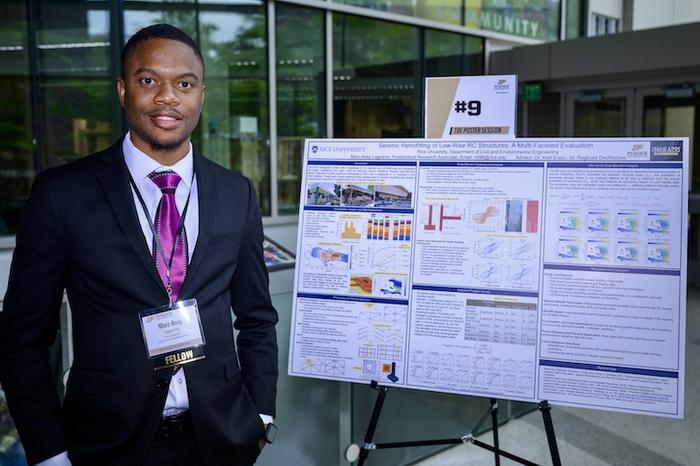Haiti’s journey through natural disasters is marked by resilience and heartbreak, particularly due to the devastating earthquakes that have struck the nation. The first quake in 2010 took a catastrophic toll, claiming an estimated 300,000 lives and leaving the infrastructure in ruins. The subsequent earthquake in 2021 further compounded the challenges faced by a nation already grappling with immense hardship. These tragedies expose the severe vulnerabilities inherent in Haiti’s building practices, as many structures were poorly designed and constructed without adequate regard for seismic resilience.
Marc-Ansy Laguerre, a postdoctoral associate in civil and environmental engineering at Rice University, aspires to change the landscape of construction in Haiti, aiming to prevent further loss of life due to inadequate infrastructure. Laguerre’s commitment to earthquake mitigation is deeply personal. Growing up in Port-au-Prince, Haiti, he experienced the chaos of the 2010 earthquake firsthand. The scenes of devastation drove him to pursue a career in civil engineering, ensuring that future generations of Haitians could live in safer, structurally sound environments.
His scholarly journey, which has led him to prestigious institutions like Rice University, is a testament to his unwavering dedication towards fostering a seismic-resilient Haiti. With a bachelor’s degree from the State University of Haiti and a master’s degree from the University of Pittsburgh, where he studied as a Fulbright Scholar, Laguerre has honed his skills in engineering and disaster risk management. He envisions applying his expertise to create educational initiatives and practical construction techniques that are both cost-effective and scalable.
At Rice University, Laguerre has forged a significant mentor-mentee relationship with Reginald DesRoches, the university’s current president and a well-regarded expert in structural engineering and earthquake resilience. DesRoches’s understanding of the unique challenges Haiti faces, paired with his authoritative knowledge in the field, has created a collaborative environment where innovative solutions can thrive. Even after transitioning to the presidency, DesRoches remains actively involved in Laguerre’s work, providing strategic guidance as they tackle the seismic issues affecting Haiti’s infrastructure.
In a recent study published in the esteemed journal Earthquake Spectra, Laguerre, alongside his mentor DesRoches and structural engineer Mohammad Salehi, undertook an extensive analysis examining the seismic vulnerability of reinforced concrete structures in Haiti. Their research is particularly significant, as it offers hope for economic retrofitting solutions that could enhance the safety of buildings. The analysis not only exposes the structural weaknesses prevalent in many Haitian buildings but also provides actionable, cost-effectiveness strategies for retrofitting.
This research highlights critical flaws in existing structures, such as inadequate column reinforcement, poor-quality concrete, and insufficient lateral load resistance — issues that drastically increase the risk of structural failure during seismic events. The team emphasizes that many of these buildings were constructed before the implementation of rigorous seismic codes, leaving them ill-equipped to withstand powerful tremors. This lack of compliance with engineering standards is a persistent issue that directly correlates with the ongoing peril faced by residents.
Among the five retrofitting techniques examined in this study, strategies like RC jacketing, which involves reinforcing existing columns with new concrete, and the installation of steel braces were found to significantly improve the ability of buildings to withstand seismic activity. Additionally, the introduction of buckling-restrained braces (BRBs) and shear walls can further fortify larger buildings, ensuring that essential infrastructure such as schools and hospitals remains intact during future earthquakes.
The research team utilized advanced 3D modeling software to simulate various earthquake forces, applying real seismic data including that recorded in Haiti. This methodological approach not only verified the effectiveness of proposed retrofitting strategies but also tailored solutions specific to the common building types found in Haiti. This innovative research is poised to influence building codes and construction practices significantly, providing a benchmark for future construction and retrofitting projects.
While engineering solutions are crucial, Laguerre stresses the necessity of educational initiatives aimed at fostering a culture of safety and resilience among Haitian builders and engineers. By implementing training programs on best practices and adherence to building codes, there can be a paradigm shift in how structures are conceived and erected. Educating contractors and workers about the implications of poor construction practices can empower communities to collectively create a safer built environment.
Part of Laguerre’s vision is to establish frameworks that facilitate collaborative efforts between the government, NGOs, and academic institutions. Strengthening policy frameworks and injecting resources into research and development will bolster Haiti’s disaster preparedness strategy. It is imperative that stakeholders work in tandem to create lasting changes that resonate with the nation’s needs, ensuring that the lessons learned from past catastrophes are woven into the fabric of future construction practices.
In essence, Haiti’s road to recovery is not solely about rebuilding what has been lost; it extends to redefining the way buildings are designed and constructed to mitigate the impacts of future seismic events. Laguerre’s research embodies a light of hope that illuminates the pathway toward revitalized infrastructure that honors both the memories of lives lost and the resilience of those who remain. Through strategy, innovation, and collaboration, a future where Haitian communities stand shielded from the wrath of nature is indeed a possibility.
The implications of this collective effort reach far beyond the confines of academia or professional engineering circles; they resonate with every Haitian who dreams of a safer home, a community built on the principle of preparedness rather than reaction. As research continues and more robust building practices are introduced, the vision of a resilient Haiti stands on the precipice of becoming reality.
Subject of Research: Seismic Retrofit of Haitian Reinforced Concrete Building Frames
Article Title: A numerical study on the seismic retrofit of Haitian reinforced concrete building frames
News Publication Date: 14-Jan-2025
Web References: Earthquake Spectra, Marc-Ansy Laguerre, Reginald DesRoches
References:
Image Credits: Credit: Rice University.
Keywords: Earthquakes, Environmental engineering, Construction techniques, Building construction, Engineering education.




